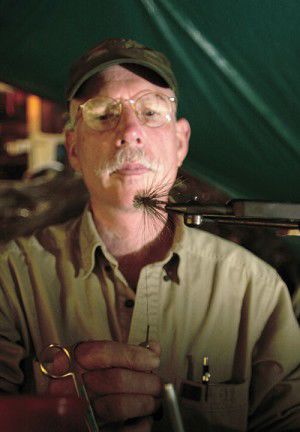Lee Spencer approaches fly-fishing for steelhead from a different point of view
Published 7:36 am Saturday, October 27, 2007

- Lee Spencer ties one of his moose hair muddler flies Sept. 21. <i>Associated Press</i>
Back in 1998 Lee Spencer did two things that changed his relationship with the big steelhead of the North Umpqua River.
He agreed to become the first full-time FishWatch guardian of the Big Bend Pool on Steamboat Creek, where as many as 400 large steelhead spend the summer in startlingly plain sight after swimming up the North Umpqua to spawn.
And he started cutting the points off the hooks on his flies.
Even people who know Spencer wonder why he would want to spend summers on Steamboat Creek 12 miles upstream from the nearest pay phone watching fish wait.
“No one else would do it,” said Joe Howell, owner of the Blue Heron Fly Shop in Idleyld Park.
It is even harder to understand why the 57-year-old would cut the points off his hooks and file the wire stump smooth – denying himself the satisfaction of controlling, touching and ultimately setting free something so wild and beautiful.
“I was uncomfortable fishing,” Spencer said. “I like these fish too much to kill them, even accidentally, or even to stress them out, unduly.
“It took me a month or a month and a half to not want to see the fish up close,” he added. “I am not proselytizing fishing pointless, but my fishing is as good or better than it ever has been, as far as my own satisfaction.”
Western writer and gentleman sportsman Zane Grey proclaimed the North Umpqua the America’s premier fishing river in a 1935 article in Sports Afield magazine. He landed 64 fish in the summer of 1934, casting down and across with a wet fly on a floating line and allowing it to swing back across the current in the British tradition of fly-fishing for Atlantic Salmon. His son, Loren, landed 100.
Still, the author wrote, “It was the steelhead I raised and could not hook, and those that I hooked and could not land, which counted.”
Spencer’s best season was that summer of 1998. A field archaeologist, he had saved enough money from his last dig to spend the summer camped in the fly-fishing-only section of the North Umpqua. It had taken him 10 years of trying to catch his first North Umpqua steelhead on a fly. By 1998 he was good enough to raise 77 steelhead in 102 days of fishing, and land about half of them. He had intended to release every one unharmed, whether wild or hatchery born, but killed three – two were bleeding from the gills and a third got disoriented and went belly-up out of his reach. A fourth left its eyeball on his hook.
“I am not a Buddhist, but I read a lot of Buddhism,” Spencer said. “It is my impression that the less harming or the more harmless my actions are in the world, the better. It probably comes down to as simple as that. It gets down to the heart of the question, ‘Why does a person cast flies,’ or ‘Why does a person catch steelhead in the first place?”‘
He got the idea from reading about Harry Lemire, a steelhead fly fisherman and fly tier from Washington, who started cutting the points off his hooks in about 1975 whenever he would get into a bunch of fish and didn’t want to waste time playing them.
“Everybody thought I was crazy,” Lemire said. “To me the whole peak of everything is the strike or the boil. Everything after that is downhill. Especially if you have to wait a long time to land the fish.
“When you get a fish on, you get a run and a jump and at the jump it will throw the hook. That was satisfying enough for me.”
Spencer also gets a lot of satisfaction from watching the fish in the Big Bend Pool, once known as the Dynamite Pool for the preferred technique of local poachers. He sits at a meditation bench with Sis, his 17-year-old Australian cattle dog, for hours on end, watching the fish and talking to the visitors who stop to see this remote and remarkable place in the Umpqua National Forest.
Steelhead are rainbow trout that spend most of their lives in the ocean, where the food and water are more plentiful than in Northwest rivers, before returning to freshwater to spawn. Steamboat Creek accounts for 70 percent of the wild steelhead in the North Umpqua, and the 400 in the pool this year – some up to 20 pounds – account for about 30 percent of the wild fish counted over Winchester Dam.
The North Umpqua Foundation, which is dedicated to helping wild steelhead in the North Umpqua Basin, pays Spencer $39 a day from spring to winter, provides the trailer he lives in, and pays a stipend over the winter, when he finds somewhere else to live and compiles his notes on the pool.
He drives an old van once owned by Dan Callaghan, the inventor of the green-butt skunk, widely considered the best traditional steelhead fly. Callaghan’s widow gave it to him. A rubber turtle hangs from the rearview mirror. Spencer gets his mail and phone messages 12 miles downstream at the Steamboat Lodge, which overlooks the waters Grey once fished.









